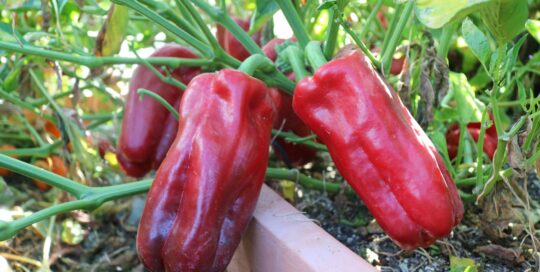How to Grow Grapes in Small-Space Gardens
Views: 9595
About three springs ago I noticed something unusual tucked into one of the plots in my community garden. I couldn’t tell what it was at first. As the summer wore on and the thick-stemmed plant grew, its identity became clear. It was a grape vine.
Since then two or three other gardeners have planted grapes in their plots. It’s kinda-sorta against the unwritten rule of limiting woody perennials, but so far the vines haven’t caused any neighborly unrest. And so they remain.
Grapes, as it turns out, are not that unusual in urban or densely populated areas.
I recall when I lived in nearby Somerville that several longtime residents of Greek heritage had neatly trimmed grape vines on stems as thick and substantial as the accents covering their carports.
The vines growing in the community garden are kept neatly trellised and trimmed. And if you look at them and consider, the vines take up about the same amount of space as some heirloom tomatoes.
How to Grow Grapes in Small Spaces
Well then, what does it take to grow them?
First, what do you want the grapes for? If you are hoping for trying your hand at winemaking, those varieties will be much different from those for eating or making into juice.
Second, your grape varieties need to be appropriate for your region. New England grapes are a lot different from Virginia grapes and California grapes. Go to your local garden center and ask. They should have varieties that work in your location.
Sun and Soil: Choose a spot. Grapes need full sun to make all those sugars in the fruit. And they need moist and well-draining soil.
Support Grape Vines: You’ll need to support the growing vines in some manner. While commercial trellising systems are 6 ft. tall or taller, there may be limits (blocking neighbors’ light and view, etc.) in urban and residential settings. Whatever you come up with to hold the vines, keep in mind that the vines get quite heavy. Make the supports substantial. As the vines grow, attach the vines to the supports and begin training the main trunk vertically and the leaders in a horizontal direction. The major pruning season is in late winter. We can revisit winter pruning at a later time.
Water and Disease Prevention: Keeping your grape well watered is the main priority here, but keeping an eye out for diseases is, too. If the vine canopy is quite thick, fungal diseases such as botrytis, as well as downy and powdery mildews can be a problem. To help prevent this, keep leaves trimmed to a point where air can circulate through the plant. This also will help sunlight get through to the developing fruit clusters, making the fruit sweeter by producing more sugars.
When to Harvest Grapes: Grapes are typically harvested in very late summer, when the sugars have built up in the fruit to acceptable levels. When exactly is that? Eat one to find out.
Meet Ellen Wells
When you’re raised on a farm, you can’t help but know a thing or two about gardening. Ellen Wells is our expert on edible gardening.…
Ellen's Recent Posts

Pepper Red Impact an All-America Selections Winner






